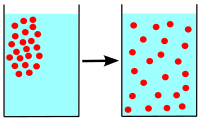
Photo from wikipedia
Abstract Hydrogen diffusion dynamics in the α-Al2O3 is very important because it associates directly with the performance of α-Al2O3 as the tritium permeation barrier (TPB) material in the tritium handling… Click to show full abstract
Abstract Hydrogen diffusion dynamics in the α-Al2O3 is very important because it associates directly with the performance of α-Al2O3 as the tritium permeation barrier (TPB) material in the tritium handling systems. In this work, the kinetics of hydrogen diffusion at the α-Al2O3 (0001) surface and hydrogen permeation into the α-Al2O3 bulk have been systematically studied by using the first-principles calculations. Results show that the vacancy defect can reduce the hydrogen migration barrier, while the Fe-doping defect can enhance the hydrogen migration barriers. This result is due to the dopant Fe showing bivalent instead of trivalent, which leads to the formation of a negatively charged center due to the substitution of divalent Fe for trivalent Al. In addition, results show quantitatively that the outer three oxygen layers (9 atomic layers) play a key role in hydrogen resistance. Hydrogen permeation from the outmost surface to the subsurface is the rate-determining step, and the corresponding energy barrier is about 3.327 eV.
Journal Title: Applied Surface Science
Year Published: 2020
Link to full text (if available)
Share on Social Media: Sign Up to like & get
recommendations!